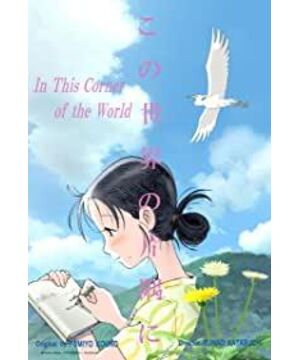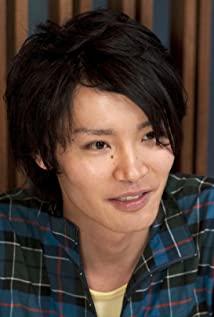The top ten films selected by Japan's "Movie Junbao" have always been one of the most important criteria for the industry to evaluate Japanese films, and in 2016, "Junbao" awarded the top ten to the cartoon "In This Corner of the World" ".
In this New Year of the Shadows surrounded by strong players, Koji Fukada, Shunji Iwai, and Kiyoshi Kurosawa all lost. your name. "The animation with such a good reputation failed to enter the top ten... What is even more rare is that this is the only animation that can top the list after "My Neighbor Totoro", and the two films have been separated by nearly 30 years. . All of these make people have to marvel at the film's ability to capture people's hearts.
The film records the life trajectory of the heroine Xiaoling from the ten years before World War II until the eve of reconstruction after the war. Similar to many children in Japanese anime, the image of Xiaoling is not perfect, which is concentrated in her attitude towards life - from the beginning of the film, she sits on a boat and draws by herself, noticing what is going on around her. Not at all distracted, in a daze, getting lost, not remembering her husband's surname, who her relatives are... The confused character is the key to establishing Xiaoling's image, and it also lays the groundwork for many tragic turning points. At the same time, she is born with a love for painting, and her imagination is very amazing, such as the "rabbit" in the sea, the "uncle werewolf" who abducts and sells children, and the colorful smoke left by the explosion of shells... All these are for life It adds a bit of fun, dilutes the cruelty of reality, and makes the whole film full of poetic and even magical colors.
Upon further observation, we will find that director Pia Yuanxiao's handling of "imagination" is very skillful and layered. Take the "Uncle Werewolf" in the opening part of selling children as an example. When she was a child, Xiao Ling met her future husband Zhou Zuo in a basket, and the subsequent development of the story proved that the two had only this brief meeting before getting married. It can be seen that this incident must be real; but then, Xiaoling's display of the reason why the two escaped is obviously a story she made up for her sister. What is the truth? How did the two escape? Or did the two meet in some other way at all? The film does not give a clear answer. But from this we found that imagination has become an indispensable part of the logic of real life, and it has become a part of the film extremely organically.
Similarly, "Sea Rabbit" and "Colored Smoke" in the film are also related to reality at different levels, so that imagination is first related to action, second to scene, and finally to text. In addition, the film also frequently uses jump cuts to increase the sense of jumping in thinking, which is both in the character's character and in addition to the usual animation expression, which is confusing and surprising. Although the final presentation of "In This Corner of the World" is obviously not as refined as the work of Studio Ghibli due to the lack of production funds, it happens to be transformed into a kind of simplicity, which to some extent shows the era of the story. Features. Looking at the top ten selections of "Movie Xunbao" over the past few years, it can be found that these films (especially the top ten) are not necessarily without shortcomings, but they must be the most humane and innovative. "Lovers" in 2015, "Only Shine There" in 2014, and "Going to Meet Little Onion's Mother" in 2013 can be said to belong to this category.
In terms of emotional tone, "In This Corner of the World" can be said to be completely on the opposite side of "bitter and hatred". It tells a bland and even slightly humorous family story from the perspective of traditional Japanese women. But as the so-called plain sees the truth, or as the characters in the film say - "Isn't life better with laughter and laughter" - compared to all similar Japanese movies in recent years and even after the war, this has become a kind of A very valuable trait.
For example, it also shows the living conditions of people near the atomic bomb. Yamada Yoji left his son with no bones, and his mother died in depression ("If You Live With Your Mother"), but the mother of this film quickly got out of the grief of her daughter's death and began to follow It also shows the life after losing a limb. Koji Wakamatsu uses a very extreme way to turn a "human" into a "worm" with only eating ability and sexual desire ("Taro Bug"), but this film does not exaggerate the pain at all. trace. It is true that the form of animation itself is more inclined to use beautiful stories to reflect cruelty, rather than to achieve the purpose of reflection directly through sensory stimulation, so it is generally more "gentle" than live-action movies; in this film, "gentle" The core of the film is an optimistic attitude towards life and an active participation in social reconstruction, which is also a key factor for the film's rave reviews in Japan.
In the face of this tragic history, no matter whether the Japanese show grief or optimism, the people of other Asia-Pacific countries are always diametrically opposed to it, and their reflections on the war have never satisfied neighboring countries. The same is true of "In This Corner of the World" - especially in the film, Xiao Ling's almost hysterical statement that she will continue to fight after hearing the Japanese emperor's unconditional surrender is unacceptable to many people. There are also critical voices in Japan: the famous screenwriter Haruhiko Arai criticized the film, saying that the film "is still the same set of 'war = murdered film'", which is reminiscent of Hayao Miyazaki (the so-called) Controversy in China for "The Wind Rises" - a film depicting a "murderer" who makes planes, how could it become an anti-war movie?
In fact, both "In This Corner of the World" and "The Wind Rises" are both reflections on the war from an individual perspective. The heroine Xiaoling in the former and Jiro Horikoshi, the hero in the latter, could have lived a peaceful life, but the war was not the case. Completely changed their lives, making the love of their life (whether it is a person or a thing) a nightmare; the subtext of Xiaoling's so-called "continue to fight" is not "continue to fight" itself, but the meaning of war. torture. From this perspective, the message conveyed by the film is undoubtedly anti-war, and only the perspective of thousands of ordinary Japanese can finally disintegrate the state-led right-wing mission and make militarism lose its survival soil.
However, it cannot be denied that the individual perspective can reveal both "the good of mediocrity" and the "evil of mediocrity". This is the limitation of perspective, and it is also the opposition contained in the "chrysanthemum" side of Japanese culture. And Xiaoling is such a contradiction. Therefore, as the "uncle werewolf" who reappears at the end of the film and waved goodbye to Xiaoling, I am afraid that what Japan wants to say goodbye is not only the haze of war, but also the evil itself.
View more about In This Corner of the World reviews











